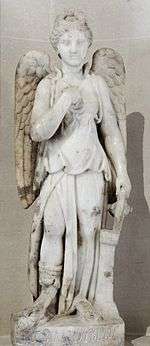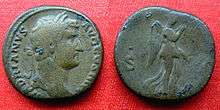Nemesis (mythology)
| Look up Nemesis in Wiktionary, the free dictionary. |
In the ancient Greek religion, Nemesis (/ˈnɛməsɪs/; Greek: Νέμεσις), also called Rhamnousia/Rhamnusia ("the goddess of Rhamnous") was the goddess who enacted retribution against those who succumb to hubris (arrogance before the gods). Another name was Adrasteia/Adrestia, meaning "the inescapable".[1] Her Roman name/counterpart is Invidia.
Etymology
The name Nemesis is related to the Greek word νέμειν némein, meaning "to give what is due",[2] from Proto-Indo-European nem- "distribute".[3]
Background
Divine retribution is a major theme in the Hellenic world view, providing the unifying theme of the tragedies of Sophocles and many other literary works.[4][5] Hesiod states: "Also deadly Nyx bore Nemesis an affliction to mortals subject to death" (Theogony, 223, though perhaps an interpolated line). Nemesis appears in a still more concrete form in a fragment of the epic Cypria.
She is implacable justice: that of Zeus in the Olympian scheme of things, although it is clear she existed prior to him, as her images look similar to several other goddesses, such as Cybele, Rhea, Demeter, and Artemis.[6]

As the "Goddess of Rhamnous", Nemesis was honored and placated in an archaic sanctuary in the isolated district of Rhamnous, in northeastern Attica. There she was a daughter of Oceanus, the primeval river-ocean that encircles the world. Pausanias noted her iconic statue there. It included a crown of stags and little Nikes and was made by Pheidias after the Battle of Marathon (490 BC), crafted from a block of Parian marble brought by the overconfident Persians, who had intended to make a memorial stele after their expected victory.[7]
She is portrayed as a winged goddess wielding a whip or a dagger.
Origins
Nemesis has been described as the daughter of Oceanus or Zeus, but according to Hyginus she was a child of Erebus and Nyx. She has also been described, by Hesiod as the daughter of Nyx alone. Her cult may have originated at Smyrna.
In some metaphysical mythology, Nemesis produced the egg from which hatched two sets of twins: Helen of Troy and Clytemnestra, and the Dioscuri, Castor and Pollux. While many myths indicate Zeus and Leda to be the parents of Helen of Troy, the author of the compilation of myth called Bibliotheke notes the possibility of Nemesis being the mother of Helen. Nemesis, to avoid Zeus, turns into a goose, but he turns into a swan and mates with her. Nemesis in her bird form lays an egg that is discovered in the marshes by a shepherd, who passes the egg to Leda. It is in this way that Leda comes to be the mother of Helen of Troy, as she kept the egg in a chest until it hatched.[8]
Acts and deeds
Although a respected goddess, Nemesis had brought much sorrow to mortals such as Echo and Narcissus. Narcissus was a very beautiful and arrogant hunter from the territory of Thespiae and Boeotia, who disdained the ones who loved him. Nemesis lured him to a pool where he saw his own reflection in the water and fell in love with it, not realizing it was only an image. He was unable to leave the beauty of his reflection and he eventually died.[9] Nemesis believed that no one should ever have too much good, and she had always cursed those who were blessed with countless gifts.
Fortune and retribution
The word Nemesis originally meant the distributor of fortune, neither good nor bad, simply in due proportion to each according to what was deserved. Later, nemesis came to suggest the resentment caused by any disturbance of this right proportion, the sense of justice that could not allow it to pass unpunished.
O. Gruppe (1906) and others connect the name with "to feel just resentment". From the fourth century onward, Nemesis, as the just balancer of Fortune's chance, could be associated with Tyche.
In the Greek tragedies Nemesis appears chiefly as the avenger of crime and the punisher of hubris, and as such is akin to Atë and the Erinyes. She was sometimes called "Adrasteia", probably meaning "one from whom there is no escape"; her epithet Erinys ("implacable") is specially applied to Demeter and the Phrygian mother goddess, Cybele.
Local cult
A festival called Nemeseia (by some identified with the Genesia) was held at Athens. Its object was to avert the nemesis of the dead, who were supposed to have the power of punishing the living, if their cult had been in any way neglected (Sophocles, Electra, 792; E. Rohde, Psyche, 1907, i. 236, note I).
At Smyrna there were two manifestations of Nemesis, more akin to Aphrodite than to Artemis. The reason for this duality is hard to explain. It is suggested that they represent two aspects of the goddess, the kindly and the implacable, or the goddesses of the old city and the new city refounded by Alexander. The martyrology Acts of Pionius, set in the "Decian persecution" of AD 250–51, mentions a lapsed Smyrnan Christian who was attending to the sacrifices at the altar of the temple of these Nemeses.
Rome

Pax-Nemesis was worshipped on occasion at Rome by victorious generals, and in imperial times was the patroness of gladiators and of the venatores, who fought in the arena with wild beasts, and was one of the tutelary deities of the drilling-ground (Nemesis campestris). Sometimes, but rarely, seen on imperial coinage, mainly under Claudius and Hadrian. In the third century AD there is evidence of the belief in an all-powerful Nemesis-Fortuna. She was worshipped by a society called Hadrian's freedmen. The poet Mesomedes wrote a hymn to Nemesis in the early second century AD, where he addressed her
Nemesis, winged balancer of life,
dark-faced goddess, daughter of Justice,
and mentioned her "adamantine bridles" that restrain "the frivolous insolences of mortals".
In early times the representations of Nemesis resembled Aphrodite, who sometimes bears the epithet Nemesis.
Later, as the maiden goddess of proportion and the avenger of crime, she has as attributes a measuring rod (tally stick), a bridle, scales, a sword, and a scourge, and she rides in a chariot drawn by griffins.
Nemesis is also known to have been called "Adrastia". Ammianus Marcellinus includes her in a digression on Justice following his description of the death of Gallus Caesar.[10]
Notes
- ↑ Aeschylus, Prometheus Bound 936; Euripides, Rhesus 342
- ↑ http://www.etymonline.com/index.php?term=nemesis
- ↑ R. S. P. Beekes, Etymological Dictionary of Greek, Brill, 2009, pp. 1005–6.
- ↑ The Nemesis Theory, University of California, retrieved October 12, 2013
- ↑ Examples of Nemesis in Literature, retrieved October 12, 2013
- ↑ The primeval concept of Nemesis is traced by Marcel Mauss (Mauss, The Gift: the form and reason for exchange in archaic societies, 2002:23: "Generosity is an obligation, because Nemesis avenges the poor... This is the ancient morality of the gift, which has become a principle of justice". Jean Coman, in discussing Nemesis in Aeschylus (Coman, L'idée de la Némésis chez Eschyle, Strasbourg, 1931:40-43) detected "traces of a less rational, and probably older, concept of deity and its relationshiop to man", as Michael B. Hornum observed in Nemesis, the Roman State and the Games, 1993:9.
- ↑ Pausanias, Description of Greece, 1.33.2-3.
- ↑ (Pseudo-Apollodorus) R. Scott Smith, Stephen Trzaskoma, and Hyginus. Apollodorus' Library and Hyginus' Fabulae: Two Handbooks of Greek Mythology. Indianapolis: Hackett Pub., 2007:60.
- ↑ "Metamorphoses (Kline) 3, the Ovid Collection, Univ. of Virginia E-Text Center". virginia.edu. Retrieved 21 January 2015.
- ↑ Ammianus Marcellinus 14.11.25
See also
- (Goddesses of Justice): Astraea, Dike, Themis, Prudentia
- (Goddesses of Injustice): Adikia
- (Aspects of Justice): (see also: Triple deity/Triple Goddess (neopaganism))
- (Justice) Themis/Dike/Justitia (Lady Justice), Raguel (the Angel of Justice)
- (Retribution) Nemesis/Rhamnousia/Rhamnusia/Adrasteia/Adrestia/Invidia
- (Redemption) Eleos/Soteria/Clementia, Zadkiel/Zachariel (the Angel of Mercy)
References
-
 This article incorporates text from a publication now in the public domain: Chisholm, Hugh, ed. (1911). "Nemesis". Encyclopædia Britannica. 19 (11th ed.). Cambridge University Press. p. 369.
This article incorporates text from a publication now in the public domain: Chisholm, Hugh, ed. (1911). "Nemesis". Encyclopædia Britannica. 19 (11th ed.). Cambridge University Press. p. 369. - http
- http://classroom.synonym.com/important-nemesis-greek-mythology-13936.html[1]
External links
| Look up Nemesis in Wiktionary, the free dictionary. |
| Wikimedia Commons has media related to Nemesis. |
- Theoi.com: Nemesis Anthology of quotes from Classical sources
- ↑ "Important Facts on Nemesis in Greek Mythology | The Classroom | Synonym". Retrieved 2015-10-04.
